| |
Home
Famous and Fascinating Women in History
Frontiersmen and Women
The World's Greatest Composers
Famous Women Spies
Great Authors of the World
Generals and other Noteworthy People
from the Civil War
The Presidents of the United States
The First Ladies of the United States
Homes and Monuments of and to
Famous People
Historical People and Events by Month for Each Day of the Year!
Famous Figures in Black History
The Calvert Family and the Lords Baltimore
Understanding the American Revolution and its People
Everything Beatles!
Everything Maryland! |
| |
|
 
|
 |  | 
James A.
Garfield, His Life, Homes, & Alexander Graham Bell
By John T. Marck
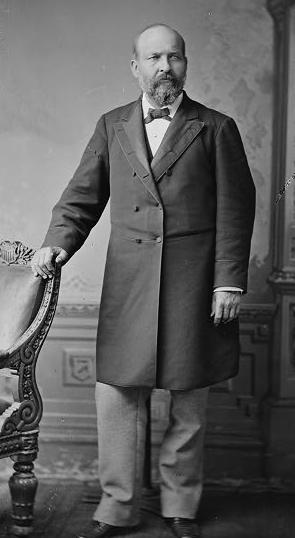
James Abram Garfield was born on November 19, 1831 in a log cabin in
Orange, Cuyahoga County, Ohio. He was the youngest of five children
born to Abram and Eliza Ballou Garfield. His father, Abram was a
native of New York, but came from Massachusetts’s ancestry, descended
from Edward Garfield, an English Puritan, who was one of the founders
of Watertown in 1630. His mother, Eliza, was born in New
Hampshire, of a Huguenot family that had fled France to New England in
1685. In 1830, Abram moved his family to Ohio and settled in
what was then called the "Wilderness." Abram did well as a
farmer and canal construction worker but sadly died at the young age
of thirty-three following a sudden illness. His wife, Eliza was
given the task of bringing up her family, unaided in a lonely cabin.
Her life was a struggle faced with poverty.
James started his schooling at the
age of three, attending classes in a log hut, but learned to read
early, a habit which he kept his entire life. Garfield loved to
read and read every book he could get his hands on. By the age
of ten, James helped out his mother's income by working at home or on
the farms of neighbors. By the time he was fourteen years old, he had
an exceptional knowledge in arithmetic, grammar and American history.
In his quest for reading, he especially enjoyed tales of the sea and
the love for these types of adventures soon consumed him. In
1848, James traveled to Cleveland where he intended to work as a
sailor on board a lake schooner, but soon realized that the work was
not the romance he once imagined. However, not wanting to return home
with no money, he took a job for a few months driving a boat on the
Ohio canal.
In 1849, after some convincing from
his mother, James entered Geauga Academy in Chester, Ohio, which was
about ten miles from his home. During vacations from school, he
learned then practiced carpentry and helped out at harvest time, doing
whatever he could to raise the money he needed to pay for school.
After his first time ended, he raised enough money so that he did not
need any aid from home, reaching a point where he was self-sufficient.
While at school in Chester, he met Miss Lucretia Rudolph, whom he
would later marry.
In 1851, upon completing his
studies in Chester, he then entered Campbellites, Hiram Eclectic
Institute, which later became Hiram College. Within a very short
time, he had an excellent knowledge of algebra, natural philosophy,
botany, Latin and Greek. Living at Hiram was inexpensive, and he
easily paid these by teaching in the English departments, as well as
gave instruction in the ancient languages. After three years, he
was quite prepared to enter his junior class at any of the colleges in
the east, and had saved the necessary tuition of $350.00. He was
originally undecided between Yale, Brown and Williams colleges, but
finally chose Williams. This decision was helped along by the
promise of encouragement by its president, Mark Hopkins.
Garfield entered Williams in the fall of 1854, and graduated with the
highest honors in the class of 1856.
After graduation in 1856, Garfield
returned to Ohio and resumed his place as a teacher of Latin and Greek
at Hiram, and the following year (1857) at the age of 26, was made its
president.
On November 11, 1858, James married
Lucretia Rudolph, with whom they had seven children. About this
time, for the first time in his life, Garfield started showing an
interest in politics. Prior to 1856, it seems that he never voted in
any election. A Republican, he cast his first vote for John
Fremont as a candidate for the presidency. When moral questions became
issues in politics, Garfield's
interest grew stronger, and he frequently discussed these issues in
debates.
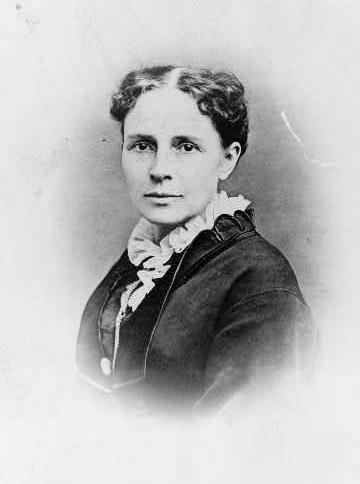
Without any solicitation or thought
on his part, Garfield was sent to represent the counties of Summit and
Portage in the senate of Ohio.
In 1860, when the Civil War began,
Garfield, who had been a farmer, carpenter, student, teacher, lawyer,
preacher and legislator, soon proved himself an excellent soldier. In
August 1861, Governor William Dennison commissioned him lieutenant
colonel in the 42nd regiment of Ohio volunteers. These men
that made up this regiment were his old pupils at Hiram whom he
persuaded to enlist.
When he was promoted as the
regiment's
commander, he drilled his men into military efficiency while awaiting
orders to go to the front. That December 1861, he reported to
General Buell in Louisville, Kentucky. Here Buell was so
impressed by the soldierly condition of his regiment that he gave
Colonel Garfield a brigade, and assigned him to the difficult task of
driving Confederate General Humphrey Marshall from eastern Kentucky.
The undertaking was a difficult one. Marshall had 5,000 men, while
Garfield had only about half that number. With this, he had to march
his brigade through a state where the majority of the people were
hostile, to attack an enemy that was strongly entrenched in the
mountains of the state. But Garfield was undaunted by this task,
and concentrated his small force, moving it quickly, in a sometimes
here and sometimes there configuration, that deceived General Marshall
so much that the Confederates abandoned their position, causing them
to lose many of their supplies at Paintville. While in their retreat,
Garfield caught them, and engaged them full force maintaining a
hand-to-hand fight for five hours. The Confederates had 5,000
men and 12 cannons, and Garfield had 1,100 men and no artillery.
Still, Garfield was able to hold off the enemy until he was reinforced
by Generals Graner and Sheldon, and when Marshall gave way, Garfield
was the victor at Middle Creek, on January 10, 1862. This proved
to be one of the most important of the minor battles during the war.
In appreciation for his service, President Lincoln made the young
Garfield a brigadier general dating this commission from the Battle at
Middle Creek.
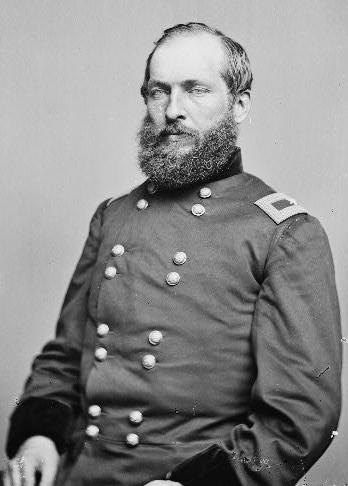
Garfield and his unit fought in
many famous battles during the war, including Shiloh, Corinth, and
also rebuilt bridges on the Memphis and Charleston Railroad, and
repaired fortifications at Huntsville.
Overtaken by the unhealthy
conditions that existed, Garfield, on July 30, 1862, returned to Hiram
where he lay ill for two months. After regaining his strength, he
reported to Washington and was ordered to court-martial duty, where he
gained a much-respected reputation. Garfield then returned to
duty under General Rosencrans who made him his chief-of-staff.
Following the Union defeat at the Battle of Chickamauga, Garfield
volunteered to take the news of the defeat to General George H.
Thomas, who held the left of the line. During Garfield's
bold, dangerous ride through constant rifle fire, he reached General
Thomas, and gave him information that saved the Army of the
Cumberland. For his actions here and for gallantry on the field,
he was made a major general on September 19, 1863. Garfield,
always unselfish, yielded his own military ambitions when he was
called by President Lincoln to go to Washington to sit in Congress.
James Garfield was 32 years old
when he entered Congress, and in December 1863, started his first term
as a representative for his home district. He would go on to be
reelected for eight consecutive terms. With his outstanding
military reputation, he was selected to serve on the Committee on
Military Affairs, then the most important job in Congress.
As to policies, Garfield was a
loyal Republican, who favored the principle that all paper money
issued by the government be secured by gold or silver, and that
following the Civil War, he sided with the radical faction of the
Republicans, who supported seizure of all property of those who had
served the Confederacy, and demanded voting rights for blacks.
At his own request in 1865,
Garfield was changed from the Committee on Military Affairs to the
Ways and Means Committee, who was most influential, and he soon became
a powerful person in the party. When James Blaine of Massachusetts
resigned his seat to serve in the Senate, Garfield assumed the
Republican leadership in the House. '
In 1880, James was elected a United
States Senator from Ohio. Before his term of office began, he became
involved in the presidential campaign of 1880. At this time, the
Secretary of the Treasury, John Sherman, another Ohioan, was running
for president. Garfield supported him, and at the convention, Garfield
addressed the crowd on his behalf. However, Garfield spoke for
15 minutes before he mentioned Sherman=s
name, and many suspected that Garfield was placing himself in
nomination.

While there is no evidence to
suggest that he was in any way disloyal to Sherman, on the 36th
ballot on the convention's
sixtieth day, Garfield was nominated for president. Garfield won the
election but did not carry the majority of the popular vote.
After the election it was then
necessary for Garfield to surrender his Senate seat and resign from
the House. On March 4, 1881, Garfield was inaugurated as the 20th
President of the United States. Once in office, Garfield was
against political corruption and took a stand against it.
The Attempted
Assassination

While planning his trip to New
England, on the morning of July 2, 1881, Garfield passed through the
waiting room at the Baltimore and Potomac Railroad Depot in
Washington, D.C. at 9:00 a.m. with his close friend, James Blaine.
Charles Guiteau, a lawyer whose application to be a U.S. Ambassador to
France was denied, fired two shots at the President.'
The first bullet grazed the
President's
arm, but the second one entered his back, fractured a rib and lodged
itself somewhere inside his body. After the shooting, Guiteau
gave himself up and reportedly had arranged for a Hanson cab to wait
for him outside to take him to jail, because he was afraid that an
angry mob might form and lynch him. The Washington police did arrest
him.
James Garfield, in spite of the
fact that he was shot by a would-be assassin, was actually killed by
his doctors. Following the shooting, President Garfield was
taken directly to the White House, during which time he never lost
consciousness. For the next eighty days, sixteen doctors were
consulted regarding the President's
condition.
The first doctor to treat the
President was Willard Bliss, who stuck his unwashed, non-sterile
finger into the wound, followed by inserting a non-sterile probing
instrument, in an attempt to locate the bullet. Bliss never
found the bullet, but the false passage he dug out confused later
doctors as to the bullets
actual path. Consequently, they concluded that the bullet had
penetrated the liver and therefore surgery would be of no help, and
the President would certainly die quickly as a result. But they were
wrong.
This was followed by an army
surgeon who also stuck his unwashed finger into the wound and dug as
deep as he could. Then a navy surgeon came along who searched with his
finger so deeply that this time he did puncture the liver, damage that
the bullet never did. He concluded that the President would die
within twenty-four hours. But, the President did not die, but his
fever rose, which was treated with milk spiked with brandy.
Unfortunately, many doctors continued to search for the bullet using
their dirty, unwashed fingers.

Enter Alexander Graham Bell
In the continuing effort to locate
the bullet, Alexander Graham Bell, the man who invented the telephone,
rigged a crude metal detector to find the bullet. After several passes
with this crude instrument, Bell announced that he found the bullet,
but it was much deeper than they originally thought. With the
President's
condition growing steadily worse, the doctors decided to cut him open
to remove the bullet, still it was not found.
What Bell had actually detected was
the metal spring under the mattress. The problem was that Bell and
others was unaware that the White House was one of only a few places
that had coil spring mattress, as they had been recently invented. Had
he known, and had he moved the President off the mattress, it was
likely they may have located the bullet. In the end, doctors managed
to take a three-inch wound and turn it into a twenty-inch deep canal
that became heavily infected.
This deep wound, combined with its
massive infection, and the blood poisoning it created, caused the
President's
heart to weaken. As a result, the President had a massive heart
attack several days later, but his well-trained doctors miss-diagnosed
this as well. They believed his attack came from a ruptured blood
vessel in his stomach. Minutes later, on September 19, 1881, the
President passed away. One can only imagine the misery he
endured during his last eighty days!
In the final conclusion it has been
determined that Garfield would have survived if his doctors had left
him alone. At his autopsy, examiners determined that the bullet
had lodged itself four inches from his spine in a protective cyst.
Garfield would have survived with the bullet inside him, as it did not
hurt any vital areas.

At the trial of Guiteau, he argued
that he did not kill the President, and that the doctors deserved all
the blame for his death. He was right, and today, this argument would
probably get you off, but in the 1880s it did not work. He was
sentenced to death and hanged on June 30, 1882.
The physicians who attended to the
President had the nerve to submit a bill for their services of $85,000
to the Senate. The federal government paid $10,000, which was still an
absurd fee. Dr. Bliss was forced to make a public apology as well.
The Homes of
James Garfield
The log cabin in which Garfield was
born on the frontier farm in Cuyahoga County no longer stands.
In 1876, Garfield purchased a home
in Mentor, Ohio known as
"Lawnfield."
Located on the shores of Lake Erie, it was originally a nine-room
farmhouse. To accommodate his wife and their five children,
Garfield added 11 rooms. After he was elected President in 1880,
and sadly his death less than one year later, his wife Lucretia added
a library and vault, which was the predecessor to the presidential
libraries popular today. In the library sits the desk from his
nine terms as a U.S. Congressman, as well as a floral wreath sent to
his funeral by Queen Victoria.
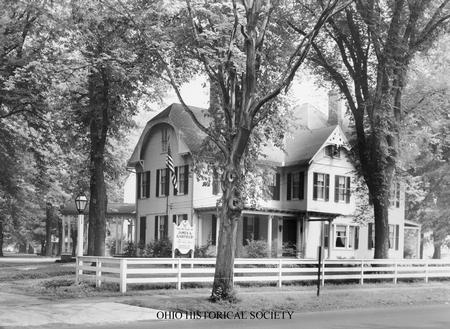
The Garfield home
"Lawnfield,"
has been restored to the period between 1880 and 1884 by the Western
Reserve Historical Society and the National Park Service. As his
descendants occupied the house until 1936, about eighty percent of the
articles and artifacts are original. The President's
great-grandson, Jim Garfield, is the groundskeeper at "Lawnfield."
Today, visitors will see a campaign
office that the President built behind the main house from which he
wrote letters and sent out telegraph messages, and it remains much the
way it was in 1880. A train stop was also established here where
thousands would travel for the chance to speak with Garfield who stood
on the front porch. This porch is one area that has undergone
improvements over the years. Between the thousands of people who
came to visit with the President during his campaign and the news
reporters who camped out on the lawn, they gave the house and grounds
its name of "Lawnfield."
These improvements made to the
porch and other areas included major foundation changes, the
replacement of the red shingle roof, and the restoration of the
gingerbread detailing. As everything done brought the house back
to its 1880-1885 period look, the exterior color schemes are accurate
to this time. Inside the house, restoration included replacing
the wallpapers with exact reproductions, and the preservation of all
wood and finishes, and the restoration of the original brass fixtures.
The estate of Lawnfield has other
houses on the grounds besides the Garfield home. These include
the 75-foot tall pump house/windmill, which has been restored, the
gasholder, granary, barn, also restored, a chicken coop with a run and
a tenant house.
The Visitor Center is the former
1893 carriage house that houses the administrative offices, exhibits
on the life of Garfield, documents, clothing, and funeral memorabilia.
Also available is an 18-minute video that describes his life and
career.
Lake View
Cemetery

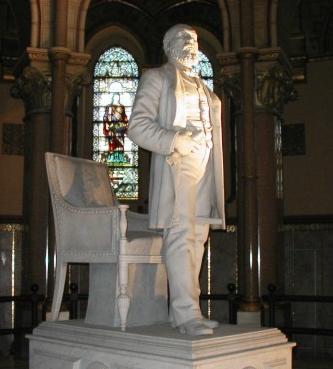
President James A. Garfield was
laid to rest at Lake View Cemetery in Cleveland, Ohio. Founded
in 1869, the cemetery sits on 285 acres of land and was modeled after
the great garden cemeteries of Victorian England and France.
Also located here at Lake View is
the Garfield Memorial. The construction of the Memorial began in 1885
and was completed five years later in 1890. It was dedicated on May
30, 1890 and among those in attendance was President Benjamin
Harrison, former President Rutherford B. Hayes and members of Garfield's
family.
This Memorial structure has been
called the first true mausoleum in America, combining both tomb and
memorial functions. A three-tiered circular tower pinnacles the
monument 50 feet in diameter and 180 feet in height that stands on a
broad stone surface. The exterior is decorated with five
life-size base relief panels depicting Garfield at various phases of
his life and career. Inside the monument in the Memorial Room is
a life-sized white Carrara marble statue of Garfield. The
caskets of Garfield and his wife Lucretia, and urns containing the
ashes of his daughter and son-in-law lie in a crypt directly under the
Memorial Room.
Another honor to the President is
the bronze figure of James Garfield on a granite pedestal with three
bronze figures at the base that depicts him as a student, warrior and
statesman. It is located near the U.S. Capitol in Washington, D.C.
Quick
Biographical Facts:
JAMES ABRAM GARFIELD
20th President
Term- March 4, 1881 to September
19, 1881
Republican Party
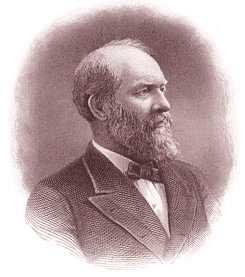
Birth: Orange Township, Cuyahoga
County, Ohio, November 19, 1831.
Ancestry: English and French
Marriage: Hiram, Ohio, November 11,
1858 to Lucretia Rudolph who was born in Hiram, Ohio, April 19, 1832.
Lucretia died in Pasadena, California, March 14, 1918 and is buried in
Lake View Cemetery, Cleveland, Ohio.
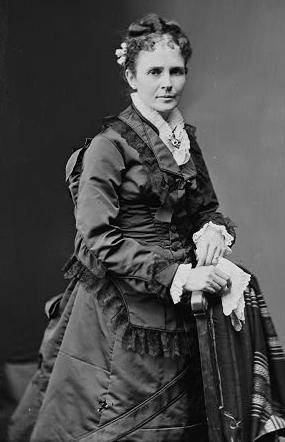
Children: Eliza Arabella
(1860-1863); Harry Augustus (1863-1942); James Rudolph (1865-1950);
Mary (1867-1947); Irin McDowell (1870-1951); Abram (1872-1958); Edward
(1874-1876).
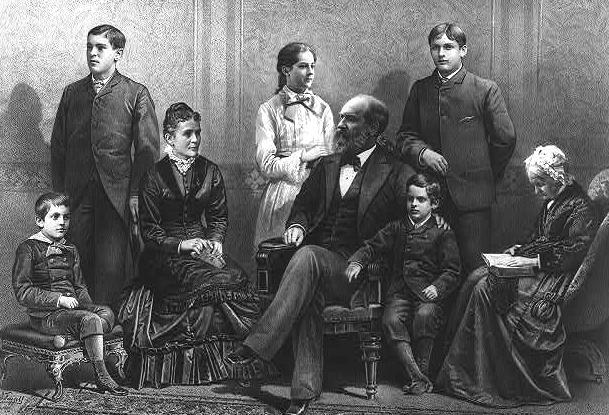
Home: "Lawnfield", Mentor, Ohio.
Education: Attended Geauga Academy
and Western Reserve Eclectic Institute; graduated (1856) from Williams
College.
Religion: Disciples of Christ.
Occupation before Presidency:
School teacher; soldier; President of Hiram College.
Military Service: Commissioned Lt.
Colonel of 42nd Ohio Volunteers in August (1861); rose to Brigadier
General of Volunteers (1862) and Major General (1863).
Pre-Presidential Offices: Member of
Ohio Senate; Member of U.S. House of Representatives; Chairman of
House Committee on Appropriations; Minority Leader in U.S. house of
Representatives.
Age at Inauguration: 49
Garfield Administration: Vice
President: Chester A. Arthur of New York
Inauguration: March 4, 1881, The
Capitol, Washington, D.C.
Writings:
Diary, 1848-1874 (2 volumes, 1967), ed. by H. J. Brown and F.
D. Williams
Death: Elberon, New Jersey,
September 19, 1881.
Cause of Death: Assassination at
age 49, July 2, 1881. He was shot by Charles J. Guiteau in Baltimore &
Potomac Railroad Station, Washington, D.C. It took Garfield 80 days to
die, after he was shot.
Place of Burial: Lake View
Cemetery, Cleveland, Ohio.
Interesting Facts:
·
Garfield was a
classics professor and would amaze people by his skill of writing
Latin with one hand and Greek with the other, at the same time. He was
also a lawyer, and at 30 years old, was at one time the youngest Union
general in the Civil War.
·
Garfield was the
first left-handed president
·
The last of seven
presidents born in a log cabin, Garfield weighed 10 pounds at birth
·
He was the first
president to campaign in two languages -- English and German.
·
On Election Day,
November 2, 1880, he was at the same time a member of the House,
Senator-elect and President-elect.
·
His mother was the first
president's mother to attend her son's inauguration.
·
At the age of
twenty-six, Garfield became president of Hiram College. At the time
the school only had five faculty members.

Copyright ©
1992-2022 by John T. Marck.
Informational assistance from Presidential Avenue and
"Lawnfield."
Additional information from The Presidents of the United States,
by John T. Marck.
A
Splendid Time Is Guaranteed For All
| | |
| |
|

